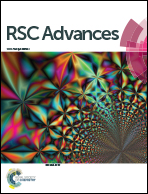Effective surface attachment of Ag nanoparticles on fibers using glycidyltrimethylammonium chloride and improvement of antimicrobial properties†
Abstract
Functional poly(m-phenylene isophthalamide), m-aramid (known as Nomex®) fibers with antimicrobial properties were prepared by applying quaternary ammonium salts (such as glycidyltrimethylammonium chloride (GTAC)) in combination with silver nanoparticles (AgNPs). The fibers treated by this simple process exhibited enhanced antimicrobial activity. In the coating process, the m-aramid fibers were immersed in a GTAC solution and reacted via the pad-dry-cure process. The GTAC-treated m-aramid fibers were then reacted with an Ag colloid solution at 40 °C for 90 min to prepare GTAC/AgNP-treated m-aramid fibers. Scanning electron microscopy was used to confirm the surface morphology of the m-aramid fibers treated with GTAC and AgNPs. Changes in the chemical composition before and after GTAC and AgNP treatment were analyzed by scanning electron microscopy with energy-dispersive X-ray spectroscopy. The tensile strength of the GTAC/AgNP-treated m-aramid fibers declined by about 3.5% compared to that of untreated m-aramid fibers. Durability of the AgNPs on the m-aramid fibers treated with GTAC/AgNPs was demonstrated through a washing-fastness test, indicating 76% retention after five washing cycles. The antimicrobial activity analysis showed that the synergistic antimicrobial properties of the GTAC/AgNP-treated m-aramid fibers resulted in efficacy against P. aeruginosa.



 Please wait while we load your content...
Please wait while we load your content...